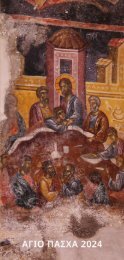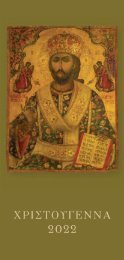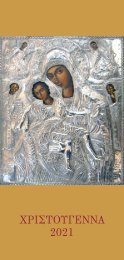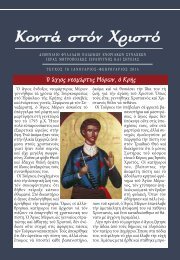You also want an ePaper? Increase the reach of your titles
YUMPU automatically turns print PDFs into web optimized ePapers that Google loves.
64<br />
T<br />
he Monastery of Exakousti [‘the Renowned’] is located in the northwest part of the<br />
province of Ierapetra between the settlements of Anatoli and Malles. Compared<br />
with other monasteries in the vicinity, such as the All-Holy Virgin of Armos at Malles and<br />
the All-Holy Virgin the Karydiani [‘of the Walnuts’] at Mythoi, it is a relatively recent<br />
monastic foundation since it was founded at the end of the 19th century. Of course, the<br />
existence, already during the period of its foundation, of the small<br />
cavernous church of the Transfiguration of Christ, as well as some<br />
local traditions, offer an indication that there may have been an<br />
older monastery in the same location. The foundation of the<br />
monastery during the late 19th century has been inextricably connected with its first<br />
monk and, later abbot, Chatzi-Ananias Barberakis, who, in 1882, completed the singlenave<br />
catholicon, dedicated to the All-Holy Virgin while at the same time he built the<br />
ne cessary buildings for his and the other monks’ habitation. The monastery was deemed<br />
to be in dissolution in the year 1935 and<br />
was abandoned until 1963 when it<br />
became active again for a short time. Its<br />
final reconstitution took place in 1976<br />
when, after its conversion into a female<br />
monastery, the first nuns became resident<br />
in the space. The building complex<br />
develops around a courtyard with the<br />
catholicon at its centre. Noteworthy is the<br />
very well crafted wood-carved altar<br />
screen, work of the noted artisans, P. and<br />
I. Makrakis, and X. Farsaris, from the<br />
settlement of Mesa in Lasithi.<br />
HOLY MONASTERY<br />
OF EXAKOUSTI<br />
Christ the Saviour. Upper (Pano) Karkasa.<br />
T<br />
he single-nave, particularly spacious, church of St. George is located<br />
on the eastern boundary of the ruined and long-abandoned village<br />
of Loutra, a kilometre to the south of the settlement of Malles.<br />
Externally, on its north side, it<br />
forms three semi-circular blind<br />
arcades while former sections<br />
are incorporated in the lower<br />
section of the walls, an indication<br />
SAINT GEORGE<br />
AT MALLES<br />
that it was built in place of a previous building, possibly middle Byzantine.<br />
In the interior, it is formed with three pointed, blind arcades on each of the<br />
longitudinal sides and has wall painting decoration of the 14th century.<br />
The iconographic programme of the church includes a large Gospel cycle<br />
with emphasis on the cycle of the Passions. From the remaining<br />
representations, of particular interest is the representation of the imposing<br />
dragon-slayer St. George, whose miniature scenes of martyrdom are<br />
depicted on the intrados of the arch; next to them, on the pier, is the All-<br />
Holy Virgin the Galaktotrofousa [‘the Milk-giver’], and, on the east arch,<br />
the realistic depiction of the haggard St. Onoufrios. Also worthy of mention<br />
is the representation of the communion of St. Mary of Egypt by Abba<br />
Zosimas on the west arch of the south wall, with the figures flanking either<br />
side of the doorframe.<br />
Right: St. George the Dragon-slayer.


















